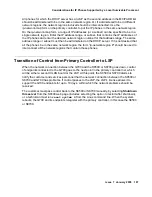
Considerations for IP Phones Supported by a Local Survivable Processor
Issue 7 January 2005
187
All phones for which the DHCP server has an LSP as the second address in the MCIPADD list
should be administered to be in the same network region. Or, if administered to be in different
network regions, the network regions involved should be interconnected. Use the
ip-network-map form on the primary controller to put the IP phones in the same network region.
On the ip-network-map form, a range of IP addresses (or a subnet) can be specified to be in a
single network region. Enter the IP address range, or subnet, that contains the IP addresses of
the IP phones and enter the desired network region number for that address range. The same
address range or subnet must then be administered on the DHCP server. If it is not desired that
all the phones be in the same network region, the form “ip-network-region #” should be used to
interconnect all the network regions that contain those phones.
Transition of Control from Primary Controller to LSP
When the network connection between the G700 and the S8500 or S8700 goes down, control
of endpoints connected to the G700 goes to the next point in the primary controller list, which
will be either a second CLAN board or the LSP. At this point, the S8500 or S8700 alarms to
notify the customer and services personnel that the network connection between the S8500 or
S8700 and G700 has problems. If control passes to the LSP, the LSP’s license allows it to
support the G700 endpoints for up to 10 days, within which the network problems should be
resolved.
The customer must pass control back to the S8500 or S8700 manually, by selecting Shutdown
this server from the S8300 web page (includes selecting the option to restart after shutdown),
or a technician must run
reset system 4
from the Linux command line. When the system
reboots, the G700 and its endpoints reregister with the primary controller, in this case the S8500
or S8700.
















































